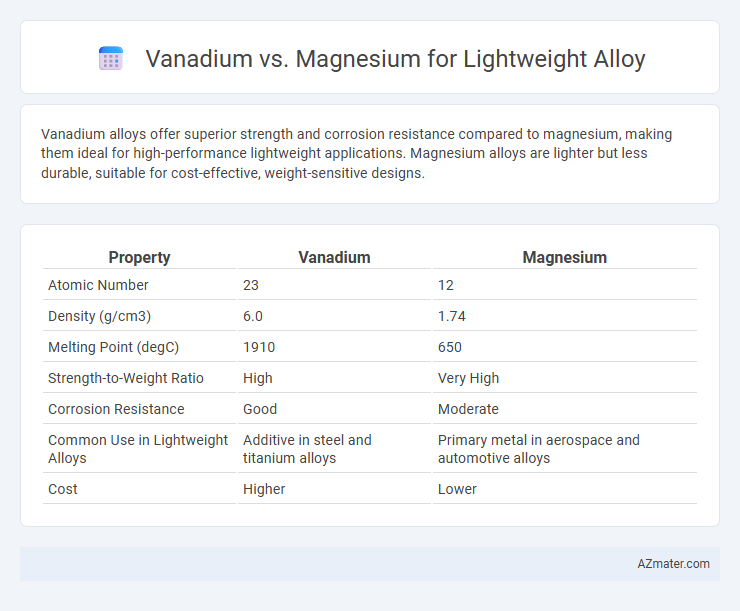Vanadium alloys offer superior strength and corrosion resistance compared to magnesium, making them ideal for high-performance lightweight applications. Magnesium alloys are lighter but less durable, suitable for cost-effective, weight-sensitive designs.
Table of Comparison
| Property | Vanadium | Magnesium |
|---|---|---|
| Atomic Number | 23 | 12 |
| Density (g/cm3) | 6.0 | 1.74 |
| Melting Point (degC) | 1910 | 650 |
| Strength-to-Weight Ratio | High | Very High |
| Corrosion Resistance | Good | Moderate |
| Common Use in Lightweight Alloys | Additive in steel and titanium alloys | Primary metal in aerospace and automotive alloys |
| Cost | Higher | Lower |
Introduction to Lightweight Alloys
Lightweight alloys, essential in aerospace and automotive industries, prioritize high strength-to-weight ratios to enhance performance and fuel efficiency. Vanadium alloys offer exceptional strength and corrosion resistance, making them suitable for high-stress structural components. Magnesium alloys are significantly lighter, providing excellent weight reduction benefits but generally exhibiting lower strength and fatigue resistance compared to vanadium-based counterparts.
Overview of Vanadium and Magnesium
Vanadium is a transition metal known for its high strength, corrosion resistance, and ability to improve the hardness and fatigue resistance of alloys, making it ideal for aerospace and military applications. Magnesium, the lightest structural metal, offers excellent strength-to-weight ratio and superior machinability, widely used in automotive and electronic components to reduce overall weight. Both metals serve critical roles in lightweight alloy design, with vanadium primarily enhancing mechanical properties and magnesium providing significant weight reduction.
Chemical Properties Comparison
Vanadium exhibits a higher melting point (1910degC) compared to magnesium (650degC), contributing to superior thermal stability in lightweight alloys. Chemically, vanadium forms stable oxides (V2O5) that enhance corrosion resistance, whereas magnesium readily oxidizes to MgO, offering less protection under prolonged exposure. The distinct valence electron configurations of vanadium (3d34s2) provide enhanced strength through interstitial alloying mechanisms, surpassing magnesium's hexagonal close-packed structure that favors lighter weight but lower overall strength in alloys.
Mechanical Strength and Durability
Vanadium significantly enhances the mechanical strength and durability of lightweight alloys by increasing tensile strength and resistance to deformation under stress. Magnesium alloys, while offering excellent weight reduction and corrosion resistance, generally exhibit lower mechanical strength compared to vanadium-containing alloys. The superior fatigue resistance and hardness of vanadium-infused alloys make them ideal for applications demanding high structural integrity and prolonged durability.
Weight Reduction Capabilities
Vanadium alloys exhibit superior strength-to-weight ratios compared to magnesium, making them ideal for applications requiring enhanced durability without compromising weight. Magnesium is significantly lighter, providing excellent weight reduction but with limited mechanical strength relative to vanadium. For lightweight alloy applications, vanadium offers a balance of weight savings and high structural performance, while magnesium prioritizes maximum weight reduction at the cost of lower strength.
Corrosion Resistance Analysis
Vanadium offers superior corrosion resistance compared to magnesium in lightweight alloy applications, particularly in harsh environments such as marine or industrial settings. Magnesium alloys tend to oxidize and degrade faster due to their high reactivity, necessitating protective coatings or treatments for long-term durability. Vanadium-enhanced alloys form stable, protective oxide layers that significantly improve resistance to corrosion, extending the lifespan and structural integrity of lightweight components.
Cost and Availability
Vanadium offers superior strength and corrosion resistance compared to magnesium but comes at a significantly higher cost due to its limited availability and complex extraction processes. Magnesium, abundant in the earth's crust, remains a cost-effective choice for lightweight alloys, making it ideal for large-scale applications despite its lower strength and susceptibility to corrosion. The price disparity and supply chain stability favor magnesium, especially in industries prioritizing affordability and scalability over extreme durability.
Industrial Applications
Vanadium, known for its exceptional strength-to-weight ratio and corrosion resistance, is extensively used in aerospace and automotive industries to enhance the durability and performance of lightweight alloys. Magnesium alloys, prized for their low density and excellent machinability, find widespread application in automotive and electronics manufacturing where weight reduction is critical. In industrial contexts, vanadium alloys offer superior mechanical properties for high-stress environments, while magnesium alloys optimize cost-efficiency and weight savings in large-scale production.
Environmental Impact
Vanadium and magnesium alloys differ significantly in environmental impact, with magnesium offering a lower carbon footprint due to its abundance and energy-efficient extraction processes. Vanadium production involves high energy consumption and mining practices that generate substantial waste and greenhouse gas emissions. Lightweight magnesium alloys contribute to improved fuel efficiency in transportation, further reducing overall environmental impact compared to vanadium-based materials.
Future Trends in Alloy Development
Vanadium and magnesium alloys are pivotal in advancing lightweight materials for aerospace and automotive industries due to their high strength-to-weight ratios and corrosion resistance. Future trends highlight the integration of nano-structured vanadium-aluminum composites and enhanced magnesium-lithium alloys through additive manufacturing techniques to improve mechanical properties and reduce weight further. Research emphasizes sustainable alloy production with recyclability and energy-efficient processing methods to meet evolving environmental regulations and performance demands.

Infographic: Vanadium vs Magnesium for Lightweight Alloy
 azmater.com
azmater.com